Rainbow Trout and/or Steelhead Trout
-
Scientific NameOncorhynchus mykiss
-
NativeNative Species
-
Identification
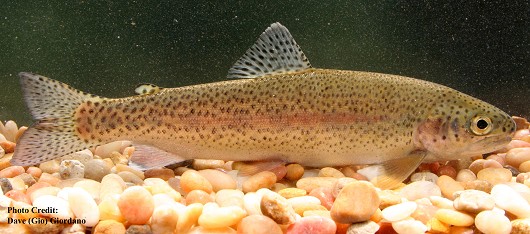 Rainbow trout, 18 cm (7”) long. Location: Deer Creek, California (Yuba River basin). Date: 6/21/2007.
Rainbow trout, 18 cm (7”) long. Location: Deer Creek, California (Yuba River basin). Date: 6/21/2007.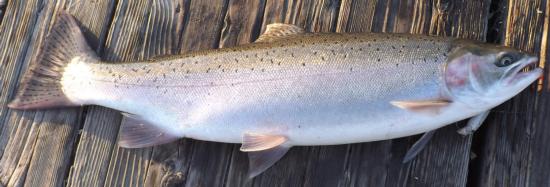 Steelhead. Caught and released in the South Fork Mokelumne River, San Joaquin County, CA, 18 Oct 2013. Photo by Gary Riddle.
Steelhead. Caught and released in the South Fork Mokelumne River, San Joaquin County, CA, 18 Oct 2013. Photo by Gary Riddle.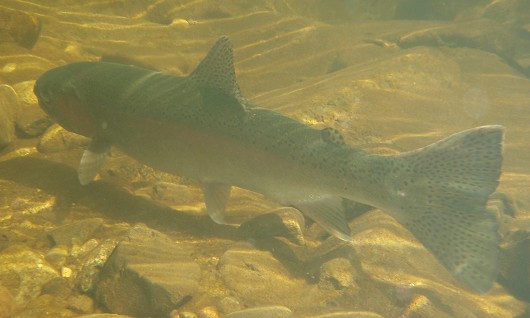 Steelhead in a Santa Monica Bay coastal stream, southern California, in February 2009. Photo by Steve Williams, The Resource Conservation District of the Santa Monica Mountains. California Department of Fish and Game provided funding for the study.
Steelhead in a Santa Monica Bay coastal stream, southern California, in February 2009. Photo by Steve Williams, The Resource Conservation District of the Santa Monica Mountains. California Department of Fish and Game provided funding for the study.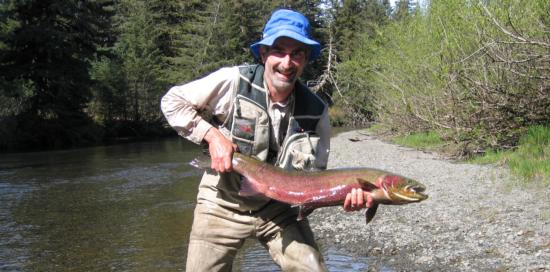 Steelhead. Location: A river in Alaska. Photo courtesy of Steve Tjosvold, UC Cooperative Extension.
Steelhead. Location: A river in Alaska. Photo courtesy of Steve Tjosvold, UC Cooperative Extension.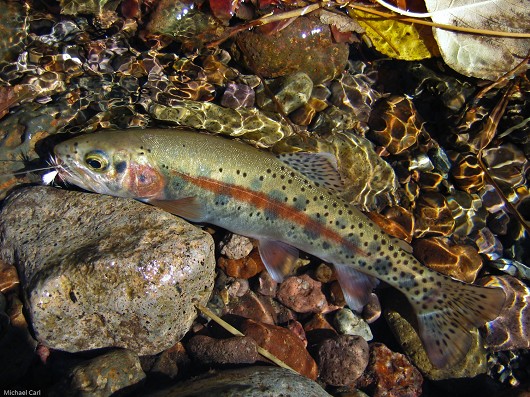 Rainbow trout (McCloud River redband), photographed at Trout Creek, California in October 2006. Photo by Michael Carl.
Rainbow trout (McCloud River redband), photographed at Trout Creek, California in October 2006. Photo by Michael Carl.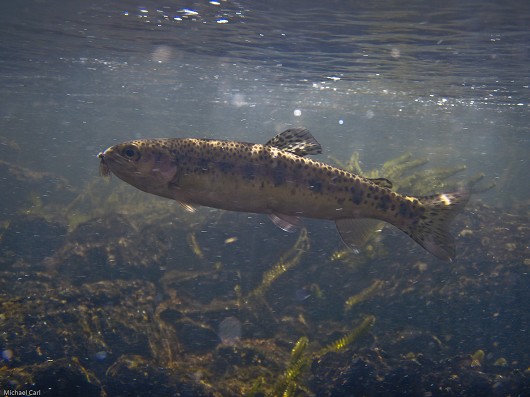 Rainbow trout (Warner Lakes redband), photographed at Mud Creek, Oregon in July 2009. Photo by Michael Carl.
Rainbow trout (Warner Lakes redband), photographed at Mud Creek, Oregon in July 2009. Photo by Michael Carl.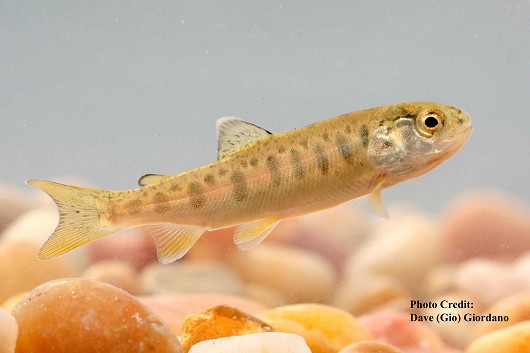 Rainbow trout fry, redband sub-species. Date: 7/10/2007.
Rainbow trout fry, redband sub-species. Date: 7/10/2007.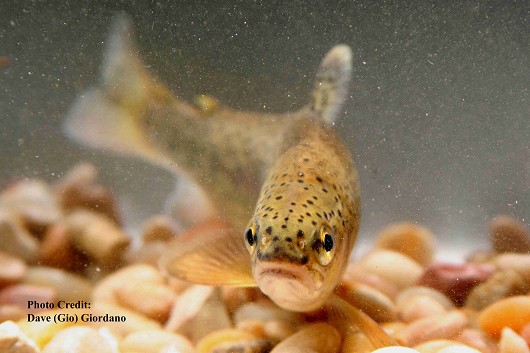 Rainbow trout, frontal view. Location: Deer Creek, California (Yuba River basin). Date: 6/22/2007.
Rainbow trout, frontal view. Location: Deer Creek, California (Yuba River basin). Date: 6/22/2007.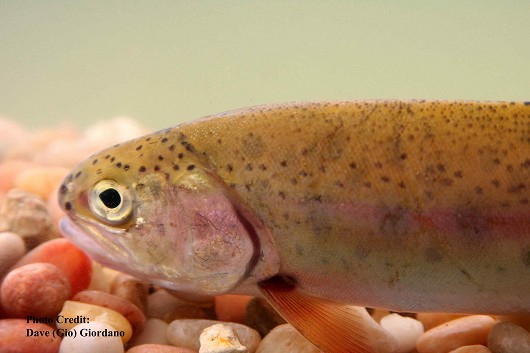 Rainbow trout, head. Date: 7/10/2007.
Rainbow trout, head. Date: 7/10/2007.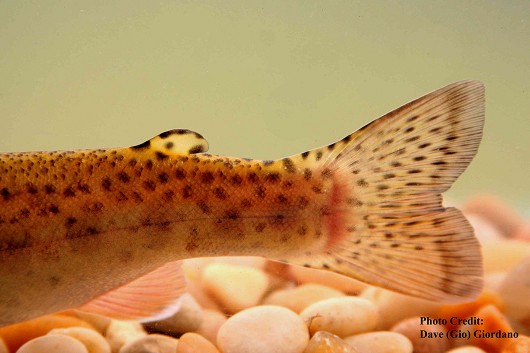 Rainbow trout, tail. Date: 7/10/2007.
Rainbow trout, tail. Date: 7/10/2007.- Commonly 35-65 cm FL and 1.4-5.4 kg; largest in CA, 12.4 kg steelhead
- Large mouth with teeth on both upper and lower jaws
- Silvery body, black spots on the adipose, dorsal, and caudal fins, pink to red lateral band
- Juvenile fish have similar appearance, possess 5-13 dark spots called parr marks that run laterally along fish’s body, parr marks are smaller than the gaps between them
- Young fish also have 5-10 dark dorsal spots between the head and dorsal fin
- Steelhead usually lighter in color than resident rainbow trout
- Fin rays: dorsal 10-12, anal 8-12, pelvic 9-10, pectoral 11-17
-
Life History
Rainbow trout are by definition a cold water fish. Optimal growth occurs at 15-18ºC and mortality typically results at 24-27ºC. New research is revealing populations of trout that are sustaining life in conditions previously considered lethal. Trout or steelhead require near saturation levels of dissolved oxygen to grow, though these fish can live at levels as low as 1.5-2.0 mg/L. Oncorhynchus mykiss generally have one of two distinct life patterns: resident inland trout and sea-run or anadromous steelhead. Some inland trout do migrate for the purpose of spawning or food foraging. Resident forms of O. mykiss often spend their entire lives within a few hundred meters of stream or within the same lake. Steelhead or sea-run trout hatch in freshwater and then migrate to the ocean, finally returning home to spawn. Times spent in freshwater and in the ocean vary according to geography, life history patterns, and effects of natural phenomena. Spawning occurs in places where the streambed is composed of gravelly substrate, usually in riffles or pool tails. The female fish digs a redd (nest) and deposits 200 to 12,000 eggs depending upon her body size. Resident rainbow trout usually produce less than 1,000 eggs per year while steelhead may produce up to 2,000 eggs per kg of body weight. After breeding the resident trout disperse to slower waters and the steelhead rest before moving back out to sea. In 3-4 weeks the eggs hatch and the young trout spend another 2-3 weeks under the cover of the gravel before emerging as fry. In some instances the fry of anadromous steelhead will emerge soon after hatching and swim straight to the ocean to avoid dry summer periods. Typically the young steelhead or parr reside in freshwater for 1-3 years before smoltification (transition to being able live in salt water). When the smolts finally reach the ocean they begin feeding on estuarine invertebrates, krill, and then focus on fish. Steelhead may stay in saltwater for 1-2 years before returning to their native streams. Most anadromous salmonids die after spawning but steelhead may make numerous trips back and forth between fresh and salt water to breed. Steelhead may spawn up to four times per life span, though the mortality rate between successive cycles is high. Rainbow trout do not commonly live beyond 6 years, though fish have been recorded to reach 9-11 years. Within a stream resident rainbows and freshwater phase steelhead have in-stream habitat preferences generally determined by size. The smallest fish are mostly found in riffles, medium sized fish in runs, and larger fish predominantly in pools. In streams and lakes rainbow trout feed on zooplankton, invertebrates, insects, drifting organisms, and sometimes other fish. Feeding usually peaks at dawn and dusk and summer consumption is greater than that in winter.
See the Golden Trout page for information about California's state fish. Golden trout are three subspecies of rainbow trout.
Video of rainbow trout:
Rainbow trout in Cow Creek, 7 June 2005. Videography by Richard Enos. Edited by Lisa Thompson, with permission. Some of this video footage was originally shown in the KVIE documentary "Sacramento: River of Life", produced by Craig Miller.
-
Links to Other Research
Wild Eagle Lake Rainbow Trout Restoration Project.
Video of collaborative research project conducted by UC Cooperative Extension, UC Davis, California Department of Fish and Game, US Forest Service, Pine Creek Coordinated Resource Management Planning Group, Susanville Indian Rancheria, and many volunteers. Produced and directed by Dave Giordano, Ecosite Media. Running time: 5 minutes 15 seconds.Wild Eagle Lake Rainbow Trout Restoration Project
Steelhead Distribution and Habitat Use in the Salinas River Watershed
Effects of Pulsed Flows from Dams on Fishes: Field and Lab Studies
Restoration of Wild Eagle Lake Rainbow Trout
Rainbow Trout Distribution and Habitat Use in Rangeland Streams
Conservation of Shasta River Coho Salmon (see reports for rainbow trout distribution)
-
Watershed
-
Alisal-Elkhorn Sloughs Watershed
-
Aliso-San Onofre Watershed
-
Antelope-Fremont Valleys Watershed
-
Applegate Watershed
-
Big-Navarro-Garcia Watershed
-
Bodega Bay Watershed
-
Butte Watershed
-
Calleguas Watershed
-
Carmel Watershed
-
Central Coastal Watershed
-
Chetco Watershed
-
Cottonwood Headwaters Watershed
-
Cottonwood Tijuana Watershed
-
Coyote Watershed
-
Cuyama Watershed
-
East Branch North Fork Feather Watershed
-
Estrella Watershed
-
Goose Lake Watershed
-
Honcut Headwaters Watershed
-
Honey-Eagle Lakes Watershed
-
Illinois Watershed
-
Lake Tahoe Watershed
-
Los Angeles Watershed
-
Lost Watershed
-
Lower American Watershed
-
Lower Bear Watershed
-
Lower Butte
-
Lower Cache Watershed
-
Lower Calaveras-Mormon Slough Watershed
-
Lower Cosumnes-Lower Mokelumne Watershed
-
Lower Cottonwood Watershed
-
Lower Eel Watershed
-
Lower Feather Watershed
-
Lower Klamath Watershed
-
Lower Pit Watershed
-
Lower Sacramento Watershed
-
Lower Yuba Watershed
-
Mad-Redwood Watershed
-
Madeline Plains Watershed
-
Mattole Watershed
-
McCloud Watershed
-
Middle Fork Eel Watershed
-
Middle Fork Feather Watershed
-
Middle Kern-Upper Tehachapi-Grapevine Watershed
-
Middle San Joaquin-Lower Chowchilla Watershed
-
Middle San Joaquin-Lower Merced-Lower Stanislaus Watershed
-
Mill Watershed
-
Mill-Big Chico Watershed
-
Mojave Watershed
-
Newport Bay Watershed
-
North Fork American Watershed
-
North Fork Feather Watershed
-
Owens Lake Watershed
-
Pajaro Watershed
-
Panoche-San Luis Reservoir Watershed
-
Russian Watershed
-
Sacramento Headwaters Watershed
-
Sacramento-Lower Cow-Lower Clear Watershed
-
Sacramento-Lower Thomes Watershed
-
Sacramento-Stone Corral Watershed
-
Sacramento-Upper Clear Watershed
-
Salinas Watershed
-
Salmon Watershed
-
San Antonio Watershed
-
San Diego Watershed
-
San Francisco Bay Watershed
-
San Francisco Coastal South Watershed
-
San Gabriel Watershed
-
San Jacinto Watershed
-
San Joaquin Delta Watershed
-
San Lorenzo-Soquel Watershed
-
San Luis Rey-Escondido Watershed
-
San Pablo Bay Watershed
-
Santa Ana Watershed
-
Santa Barbara Coastal Watershed
-
Santa Clara Watershed
-
Santa Margarita Watershed
-
Santa Maria Watershed
-
Santa Monica Bay Watershed
-
Santa Ynez Watershed
-
Scott Watershed
-
Seal Beach Watershed
-
Shasta Watershed
-
Smith Watershed
-
Smoke Creek Desert Watershed
-
South Fork American Watershed
-
South Fork Eel Watershed
-
South Fork Kern Watershed
-
South Fork Trinity Watershed
-
Suisun Bay Watershed
-
Surprise Valley Watershed
-
Tomales-Drake Bays Watershed
-
Trinity Watershed
-
Truckee Watershed
-
Tulare-Buena Vista Lakes Watershed
-
Upper Bear Watershed
-
Upper Butte
-
Upper Cache Watershed
-
Upper Calaveras Watershed
-
Upper Chowchilla-Upper Fresno Watershed
-
Upper Coon-Upper Auburn Watershed
-
Upper Cosumnes Watershed
-
Upper Cow-Battle Watershed
-
Upper Deer-Upper White Watershed
-
Upper Dry Watershed
-
Upper Eel Watershed
-
Upper Elder-Upper Thomes Watershed
-
Upper Kaweah Watershed
-
Upper Kern Watershed
-
Upper King Watershed
-
Upper Klamath Watershed
-
Upper Los Gatos-Avenal Watershed
-
Upper Merced Watershed
-
Upper Mokelumne Watershed
-
Upper Pit Watershed
-
Upper Poso Watershed
-
Upper Putah Watershed
-
Upper San Joaquin Watershed
-
Upper Stanislaus Watershed
-
Upper Stony Watershed
-
Upper Tule Watershed
-
Upper Tuolumne Watershed
-
Upper Yuba Watershed
-
Ventura Watershed
-
Warner Lakes Watershed
-
Please note, watersheds are at the USGS 8-digit Hydrologic Unit Code (HUC) scale, so they often include a lot of sub-watersheds. If a species occurs in any sub-watershed within the HUC, the species appears within the HUC. Link to an EPA page that shows HUCs.









